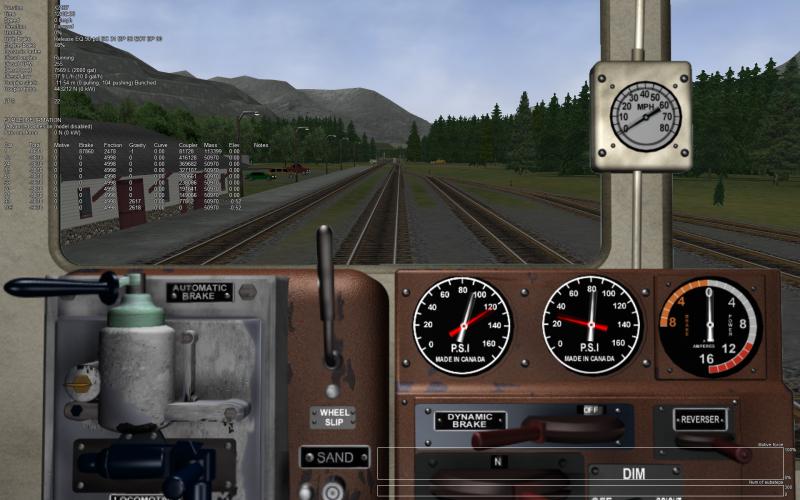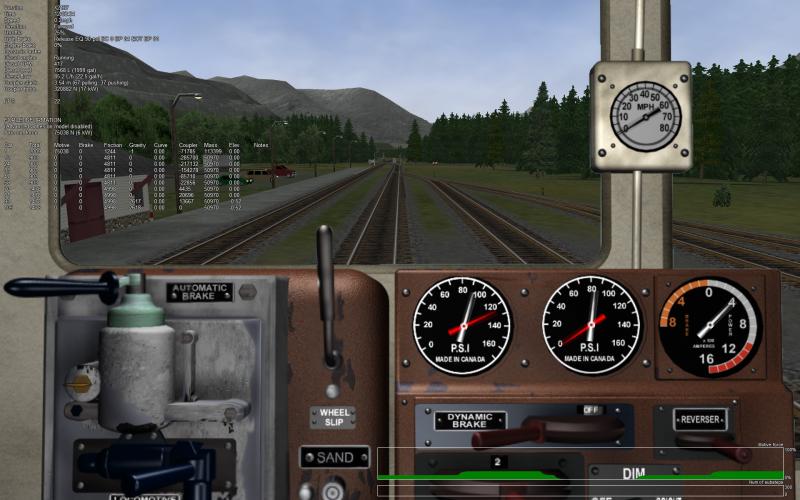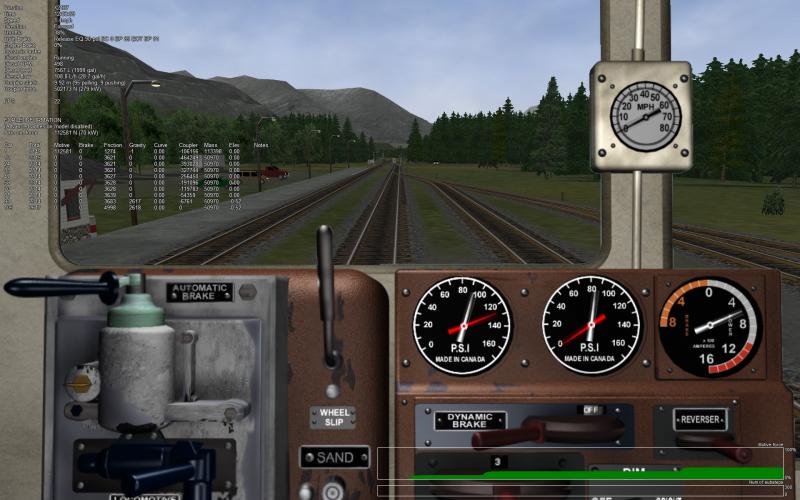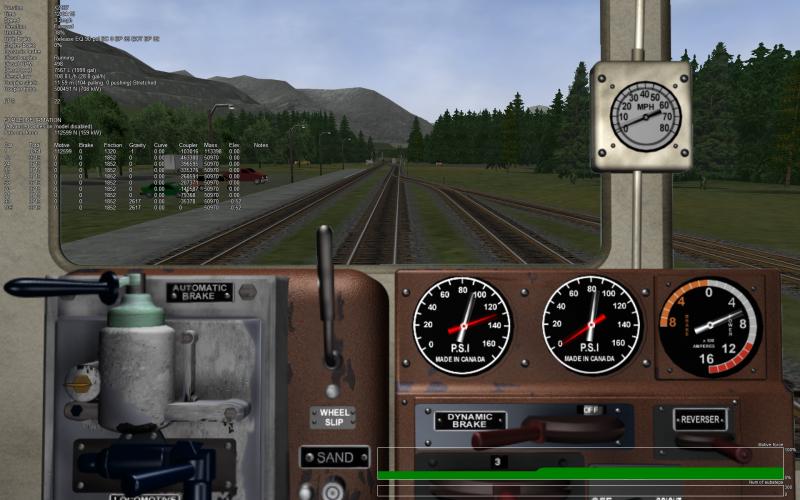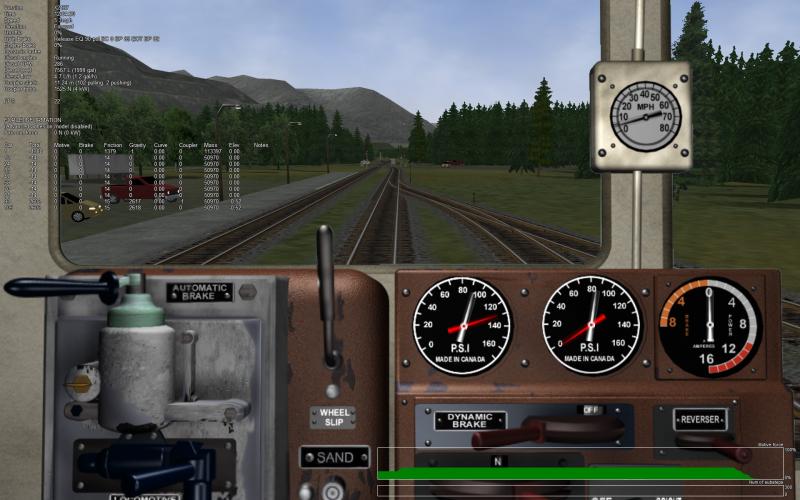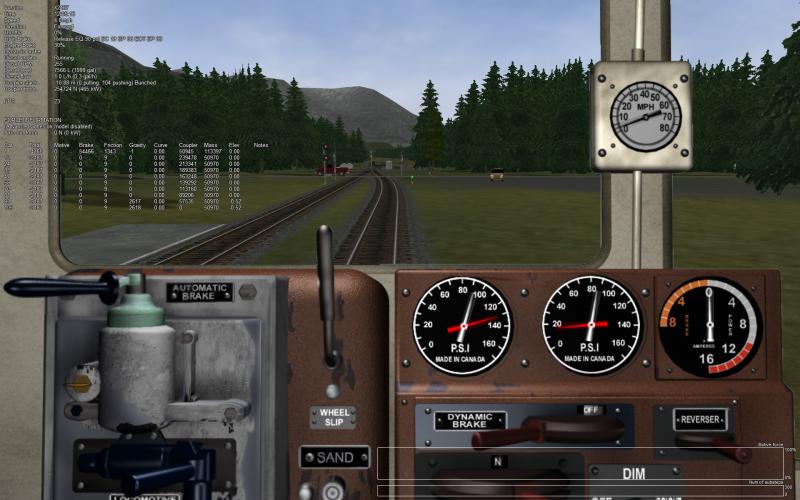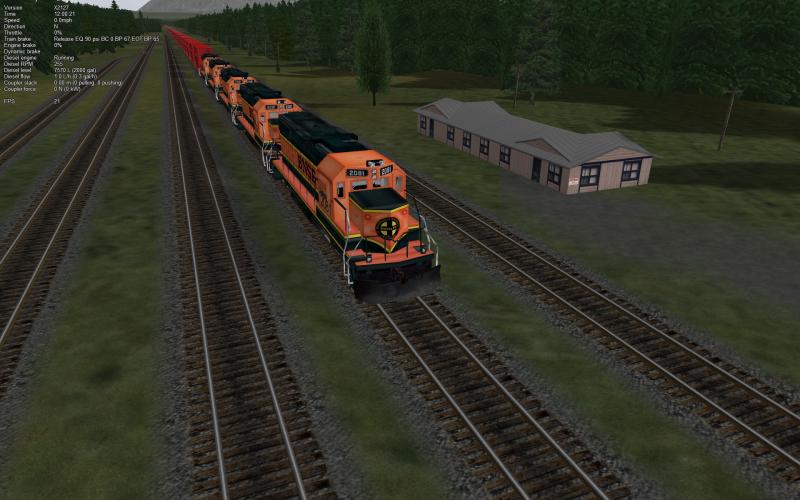Friction high in low speed
#11

Posted 01 April 2014 - 09:10 AM
On this issue, expected some change?
Remains high friction, low speed, and despite writing the 'wag' 'Friction' portion of anything, does not take account of the program, only the mass.
Thank you for your answer.
I'm sorry, I'm using google translator.
#12

Posted 04 April 2014 - 12:57 PM
If you stay in a hill, when starting again will not locomotives have power to start the train again.
you have to have twice as many locomotives for it to start the train.
I'm guessing now but if it is 8 per thousand downhill so will not train to roll down by itself due to the friction low speed.
Run8 train simulator will not have this behavior when starting the train and it is considered to the be close to real life as I understand it.
I have drive swedish train and they have not more friction in low speed.
Discovery I have seen Canadian grain train with 13000 tons and three locomotives (sd90).
It will never work in this simulator right now if the train stop uphill.
I believe this is wrong on most cars that are out there on the track, but it could probably be a little different opinions on this.
But it has clearly become more boring to drive trains now when you get stuck with the train.
#13

Posted 04 April 2014 - 11:15 PM
in ORTS we are trying to mimic MSTS behavior. Since there is a definition of Starting Resistance in the ENG files, we are using it. If there is no such definition in the ENG file, we assume some lower value. The starting friction comes from theory and from older railway engineering. Cars become better, especially bearings, rails, wheels. All this stuff brings better performance and lower friction. In general, we should keep this feature to allow early trains to be modelled. I'd suggest to edit the data - ENG/WAG files to match the real world performance. You are allowed to set the starting friction to be equal to the zero speed friction.
Cheers,
Matej
#14

Posted 05 April 2014 - 10:40 AM
You're talking about locomotives (eng files) and they behave probably right as I understand.
But my problem is wagons (wag files).
It seems not to matter what value you change in the friction part of wag file.
You get still 5000-6000 in value in F5 skin at the start of the train. See attached photos (first acceleration to 6 mph and then stop the train)
I have tested this value (+ many more). very very low value
Friction (5N/m/s(C1)_________0(E1)_________0mph(V2)________2.61N/m/s(C2)__________1.5(E2)
5.1N/rad/s 1-1rad / s 0 1
The formula by Fcalc 2:0
F=C1*VE1 if V2<0
F=C1*V E1 if V≤V2 _____In start then (5* 0 raised 0=0 Friction)
F=C1*V2E1 + C2*V2 + C2*(V-V2)E2 if V>V2_____ 1 Mph (5* 0 raised 0 + 0*0 + 2,61*0.89408 raised 1,5=2,19 Friction)
But still it is very much friction up to 5 mph when you see that it becomes normal with the values you have in the wag file.
the problem as I see it from 0 mph up to 5 mph on modern wagons.
#15

Posted 05 April 2014 - 10:22 PM
I would like to add some input to this discussion.
Firstly some background to ensure that we are all working on a "common knowledge base".
The principle resistances referenced when discussing trains are as follows:
i) Rolling resistance - this is the resistance that resists a trains movement on flat straight track.
ii) Grade Resistance - this is the resistance experienced by the train as it climbs a hill
iii) Curve resistance - this is the resistance that a train experiences as it traverses a curve.
To get a train to move and enable its continued movement requires the locomotive to be able to overcome the sum of these resistance values.
It appears that the discussion so far has mainly been centred around rolling resistance, so I will contain my input to this form of revision initially.
In 1926 a series of empirical formula were developed by W. L. Davis to calculate the resistance effect due to a train on straight level track.
These were developed in the following form:
R = A + B V + C D V2
where v = train speed and A, B, and (CD) were know as the "Davis" coefficients.
These coefficients have been modified slightly over the years.
A good reference document is the Baldwin Locomotive Data Book - train resistance starts on pg 41
The Davis formula is only considered accurate at speeds over 5mph. The starting resistance will vary depending upon the type of bearings used by the rolling stock, roller bearings will have less starting resistance then a journal (or friction bearing) as used upon older stock.
The starting resistance for a journal bearing was considered to be about 20lbs/ton, and a roller bearing was considered to be around 50% of this value. Once the train commences to start moving then the resistance will reduce, and then start to increase as air resistance, etc starts to increase.
Hence the variation in friction around the 5mph mark.
 jorgen, on 05 April 2014 - 10:40 AM, said:
jorgen, on 05 April 2014 - 10:40 AM, said:
5.1N/rad/s 1-1rad / s 0 1
The formula by Fcalc 2:0
F=C1*VE1 if V2<0
F=C1*V E1 if V≤V2 _____In start then (5* 0 raised 0=0 Friction)
F=C1*V2E1 + C2*V2 + C2*(V-V2)E2 if V>V2_____ 1 Mph (5* 0 raised 0 + 0*0 + 2,61*0.89408 raised 1,5=2,19 Friction)
MSTS, in my understanding has the following issues:
i) Does not use the Davis values, but its own version of them. FCalc2 attempted to try and approximate the closest possible values based upon the Davis formula. You can see the actual Davis values calculated by FCalc by selecting one of the FCalc options.
ii) It does not discriminate between roller and journal bearings. The effect for roller bearings has been attempted to be done through tweaking the Friction values by the player, but this is not an accurate way of doing it.
OR has attempted overcome some of the above accuracy aspects by going back to first principles rather then using the potentially "simple" approach used by MSTS.
For more details on the additional parameters that OR will accept and use to calculate friction more accurately - see this thread.
 jorgen, on 05 April 2014 - 10:40 AM, said:
jorgen, on 05 April 2014 - 10:40 AM, said:
the problem as I see it from 0 mph up to 5 mph on modern wagons.
At present OR uses the starting resistance values described in the Baldwin reference document above. It calculates the friction value at 5mph based on the Davis formula, and then reduces the friction proportionally to this value as speed increases from 0 to 5 mph. Once 5mph is reached the Davis formulas take over.
 jorgen, on 04 April 2014 - 12:57 PM, said:
jorgen, on 04 April 2014 - 12:57 PM, said:
It will never work in this simulator right now if the train stop uphill.
Based upon the sum of the train resistances described above, the worst place to attempt to start a train will be on curve that is on an uphill gradient, as all three resistance will need to be overcome by the locomotive(s).
This seems a large weight for three locomotives to start on a hill, depending upon the gradient. Do you have the actual load tables for the locomotives in question? Typically locomotives were not permitted to be loaded at any higher rates then what they could pull from a standing start up the ruling gradient for the route. This might be relaxed in some instances if the train was not allowed to be stopped at a signal on a gradient and could use its momentum to carrying it up the gradient.
In summary what MSTS allowed trains to do may not be what was realistic to "real life", so the performance of OR should not be measured against MSTS.
The best way to test the accuracy would be to get actual locomotive load tables, ensure that wagons and locomotives are correctly modeled, and the run the train over and appropriately graded route.
Cheers
Peter
#16

Posted 07 April 2014 - 06:05 AM
 jorgen, on 05 April 2014 - 10:40 AM, said:
jorgen, on 05 April 2014 - 10:40 AM, said:
Well, I'd like to explain, what 5000-6000 values mean:
All the forces are in Newtons. The normal value for zero speed should be 15 - 25 Newtons per ton for fully loaded freight wagons, 20 - 50 Newtons per ton for empty freight wagons. Having this starting resistance at 5000 - 6000 Newtons for 50 ton car means that it is 5-times higher than expected - that implies it is based on old bearing types (it might be ORTS bug). What is very strange to me: the friction values at 4mph are about 9 Newtons!!! Do you realize what force 9 Newtons is? it's like 1 kg mass can move that car e.g. using pulley. That's far far away from reality (in other words: if you build a car like this, you'd be very rich). I recommend to revise the WAG files and the friction definitions.
Cheers,
Matej
#17

Posted 07 April 2014 - 07:18 AM
I have a test wagon that is used to test things like this. Using the Open Rails Davis equations a 100 ton wagon will have over 5K resistance at rest even with roller bearings activated. This figure is the same no matter what you use for the ORTSDavis_A line, the only thing that makes a difference is the weight. Bring that down to 24 tons and starting resistance is still close to 1500. Even using your extreme value of 50 Newtons per ton, the starting figure should only be 1200.
Actuals with an empty weight of 24 tons and an Fcalc Davis A of 1058 are
0mph = 1472, 2mph = 1242, 3mph = 1163, 4mph = 1083, 5mph =1000. At 5.1mph it was 999 and after that the curve begins to rise as expected, at 6mph it has risen to 1009.
#18

Posted 07 April 2014 - 07:43 AM
 Matej Pacha, on 07 April 2014 - 06:05 AM, said:
Matej Pacha, on 07 April 2014 - 06:05 AM, said:
Cheers,
Matej
Hi
These values I just had to test the wagons rolling ability.
I know it's unrealistic values. C1 was 5N/m/s.
Someone wrote that you could get the wagon to roll easily if you changed
these values in WAG file. But it did not make any difference at all no matter what I changed in the wag file up to 5 mph.
i have tested to changed C1____E1____V2_______C2_____E2 to different values.
I know that C1 should be kind 1000N/m/s and the other values of approximately 1
But it makes no difference anyway, it is still much friction in the start.
Yesterday I had over 10,000 in value in F5 on a grain wagon up to 5mph
The wagon weighed over 100 tons.
So my experience is that it is the weight that determines the friction it is in the start
as you write above.
#19

Posted 07 April 2014 - 10:52 AM
#20

Posted 08 April 2014 - 01:39 AM
Some further insight into starting resistance.
Starting Resistance (applies in the range 0-5mph)
The Starting Resistance has been modeled based upon the Baldwin reference from the above post.
ie
Starting Resistance = 20 x wagon weight (US tons) - friction or journal bearings
Starting Resistance = 12 x wagon weight (US tons) - roller bearings
Both of these formulas give units in lbf.
Starting resistance has no relationship to the Davis values or the MSTS values, it is purely calculated based upon the stock weight.
Or will default to the friction or journal bearing if the relevant ORTS parameter is not in the eng file.
Worked example - 50 ton (uk) wagon - friction or journal bearings (default values)
50 ton (uk) = 50.8 tonne = 56 ton (us)
SR = 20 x 56 = 1120 lbf = 4982 N
If OR is told that this is a roller bearing wagon, then the SR should instead be = 2982 N
Once the train starts to move these values should drop to a minimum @ 5mph, and then start to increase again.
Cheers
Peter

 Log In
Log In Register Now!
Register Now! Help
Help





